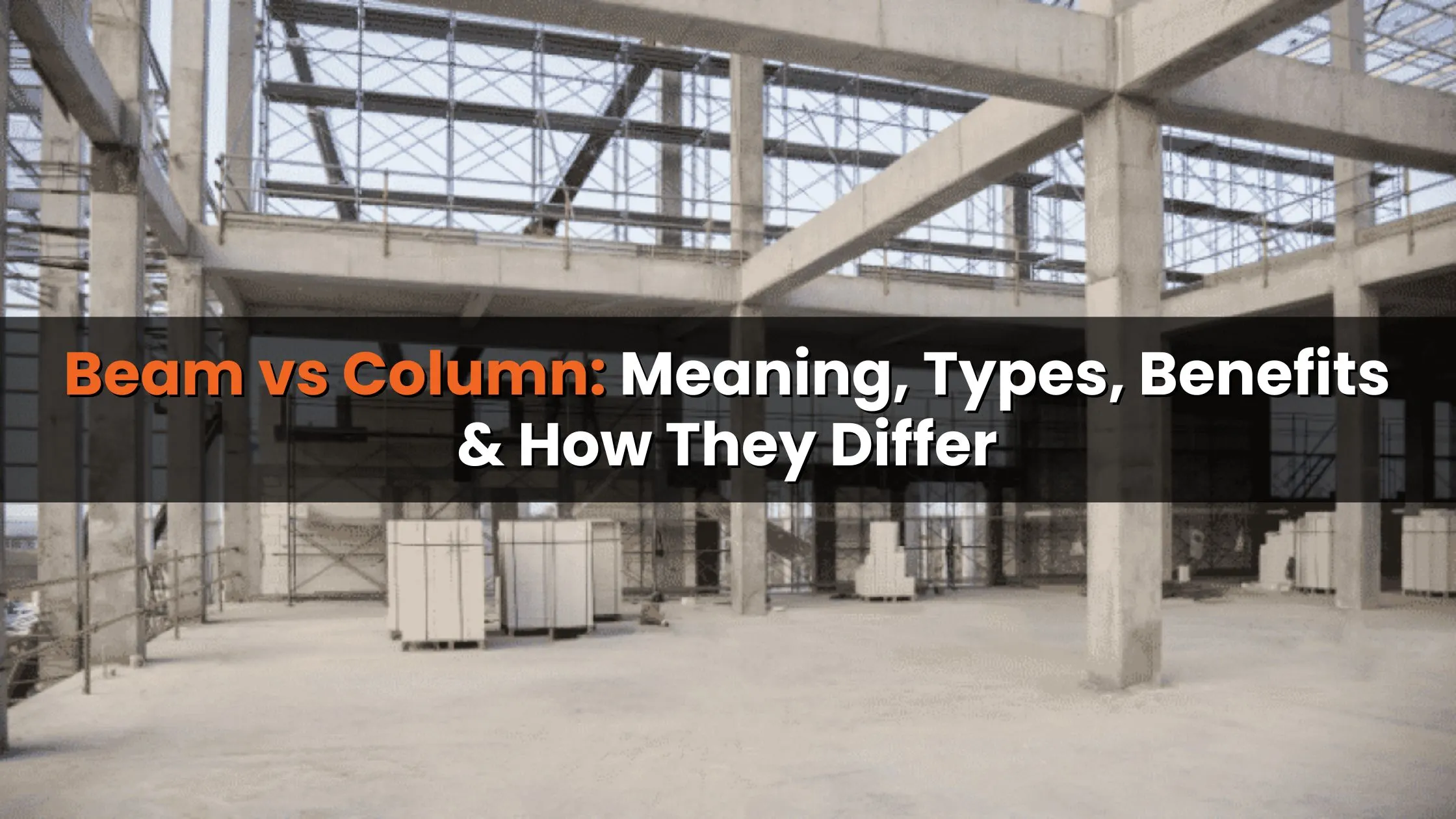Table of Content
When it comes to constructing a building, understanding the fundamental components of a structure is crucial. Two of the most essential elements are beams and columns. Although both are load-bearing members, their orientation, function, and role in the building framework are entirely different. Knowing the difference between a beam and a column is vital for architects, engineers, and even homeowners who want a better grasp of construction basics.
In this article, we’ll explore Beam Vs Column, their types, benefits, and key differences to help you understand how each contributes to a safe, stable, and durable structure.
What is a Beam? (Horizontal Load-Bearing Member)
A beam is a horizontal structural member designed to carry vertical loads. It transfers the weight of floors, roofs, or walls to the vertical supports like columns or walls. Beams resist bending and shear forces, ensuring that the load is distributed evenly across the framework. They act as the backbone for horizontal stability in buildings, bridges, and other structures.
Also Read: Smart Energy Saving Made Easy: Top Home Tips for Lower Electricity Costs
Types of Beams
Beams can be categorized based on support, shape, or material. Here’s a simplified table to understand the main types:
|
Basis |
Type of Beam |
Description / Role |
|
Based on Support |
Simply Supported Beam |
Supported at both ends. Common in floors and roofs. |
|
Cantilever Beam |
Fixed at one end, free at the other (e.g., balconies). |
|
|
Fixed Beam |
Both ends fixed, resists rotation and bending. |
|
|
Continuous Beam |
Spans across more than two supports for stability. |
|
|
Based on Shape |
Rectangular / T-Beam |
Common in RCC structures for better strength. |
|
I-Beam / Universal Beam |
Used in steel construction for high bending resistance. |
Benefits of Using Beams
- Design Flexibility: Beams allow open interior spaces without compromising structural integrity.
- Load Distribution: They transfer loads evenly to vertical supports, reducing stress concentrations.
- Structural Stability: Properly designed beams enhance lateral stability, improving resistance to wind and earthquake forces.
What is a Column? (Vertical Load-Bearing Member)
A column is a vertical structural member that primarily carries loads parallel to its axis. Its main purpose is to transfer the cumulative weight of the structure directly to the foundation. Columns are mainly subjected to compressive stress and can fail by buckling (if slender) or crushing (if short and heavily loaded). They form the vertical backbone of any building, ensuring stability and support for multiple floors.
Types of Columns
Columns are classified based on shape and slenderness. Here’s a concise table for clarity:
|
Basis |
Type of Column |
Description / Role |
|
Based on Shape |
Square / Rectangular |
Common in RCC buildings for simplicity and stability. |
|
Circular |
Used for aesthetic appeal and uniform load distribution. |
|
|
L-Shape / T-Shape |
Ideal for corners and junctions. |
|
|
H-Shape / Wide Flange |
Common in steel structures for better strength. |
|
|
Based on Slenderness |
Short Column |
Fails by crushing under axial load. |
|
Long Column |
Fails by buckling when slender. |
Benefits of Using Columns
- Direct Load Transfer: Columns carry loads vertically down to the foundation efficiently.
- Vertical Expansion: They make multi-story construction feasible by supporting successive floors.
- Framework Stability: Columns prevent instability and maintain the overall structural integrity.
Also Read: M20 Grade Concrete: Mix Ratio, Strength, and Uses Explained
Beam Vs Column: Key Differences
While both beams and columns are essential load-bearing members, their characteristics and roles are distinct. Understanding these differences is important for anyone involved in building design or construction.
|
Feature |
Beam |
Column |
|
Orientation |
Horizontal |
Vertical |
|
Primary Load |
Transverse (perpendicular) |
Axial (parallel) |
|
Main Stress |
Bending & Shear |
Compression |
|
Failure Mode |
Bending / Deflection |
Buckling / Crushing |
|
Structural Role |
Distributes loads sideways |
Transfers loads vertically |
|
Supports |
Slabs, walls, roofs |
Beams, slabs, foundations |
|
Function in Framework |
Horizontal skeleton |
Vertical backbone |
Conclusion
Understanding Beam Vs Column is fundamental for anyone involved in building design, construction, or structural analysis. Beams provide horizontal support, distributing loads to columns, while columns carry these loads vertically down to the foundation. Together, they form a stable, durable, and safe structural framework.
By knowing the types, benefits, and differences of beams and columns, engineers can design structures that withstand environmental stresses, and homeowners can better appreciate how every component contributes to the safety and longevity of their buildings.
Properly designed beams and columns are not just structural necessities they are the backbone of every strong, reliable building.










Ans 1. A beam is a horizontal structural member that carries vertical loads and distributes them to columns or walls, while a column is a vertical member that transfers loads from beams and slabs directly to the foundation.
Ans 2. Beams are classified based on support (simply supported, cantilever, fixed, continuous) and shape/material (rectangular, T-beam, I-beam/steel beams).
Ans 3. Columns are categorized by shape (square, circular, L-shape, H-shape) and slenderness (short columns fail by crushing, long columns fail by buckling).
Ans 4. Beams provide horizontal support, distribute loads evenly to vertical members, enhance structural stability, and allow open interior spaces without compromising strength.
Ans 5. Columns carry vertical loads from beams and slabs to the foundation, enable multi-story construction, and maintain the overall stability of the structure.
Ans 6. Beams primarily experience bending and shear stress due to the loads applied perpendicular to their length.
Ans 7. Columns are mainly subjected to compressive stress along their axis and can fail due to buckling or crushing depending on their height and load.
Ans 8. Beams form the horizontal framework, supporting slabs and walls, while columns act as the vertical backbone, transferring loads safely to the foundation.
Ans 9. No, beams rely on vertical supports like columns or walls to transfer loads; without columns, the structure would lack stability.
Ans 10. Beams typically fail by bending or deflection, while columns fail by buckling (long columns) or crushing (short columns) under axial loads.